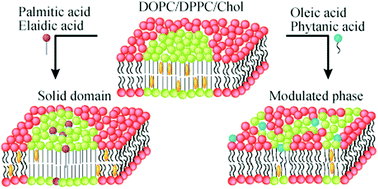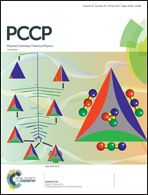Formation of modulated phases and domain rigidification in fatty acid-containing lipid membranes†
Abstract
We investigated the phase behavior of lipid membranes containing fatty acids (FAs) by microscopy and differential scanning calorimetry. We used palmitic acid (saturated FA), oleic acid (cis-isomer of unsaturated FA), elaidic acid (trans-isomer of unsaturated FA), and phytanic acid (branched FA) and examined the effects of FAs on phase-separated structures in lipid bilayer membranes consisting of dioleolylphosphocholine (DOPC)/dipalmitoylphosphocholine (DPPC)/cholesterol (Chol). Palmitic acid and elaidic acid exclude Chol from the DPPC-rich phase. As a result, the liquid-ordered phase formed by DPPC and Chol transforms into a solid-ordered phase. Oleic acid and phytanic acid significantly reduce the line tension at the liquid domain boundary. This decrease in line tension leads to the formation of modulated phases, such as striped, hexagonal, and polygonal domains. We measured the line tension and the interdomain interaction in these specific domains by an image analysis. The result showed that oleic acid and phytanic acid-containing vesicles as well as palmitic acid-containing vesicles are not spherical, and this domain-induced deformation is explained theoretically.



 Please wait while we load your content...
Please wait while we load your content...